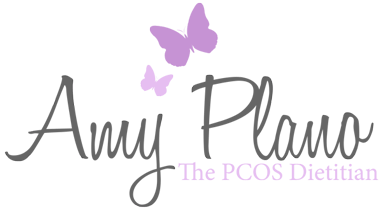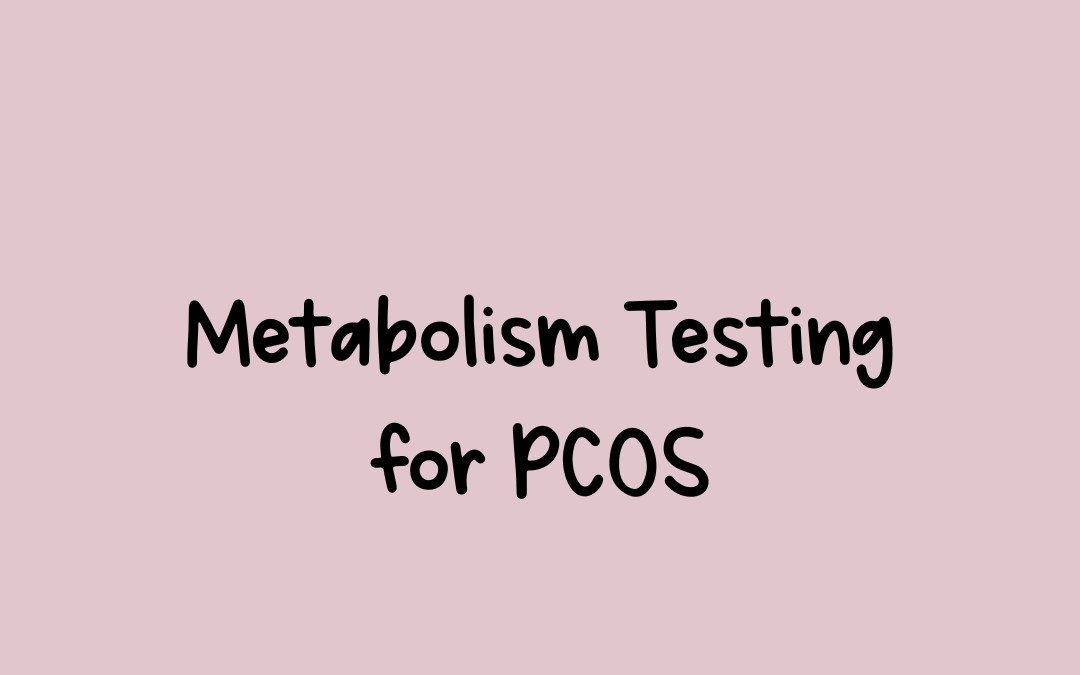
by AmyPlano | Jun 8, 2023 | PCOS and metabolism, PCOS and Weight Gain, Weight Loss
Do you have PCOS and are unable to lose weight in spite of an intense exercise regime and a disciplined diet? Have you hit a plateau in your weight loss? Would you like to take the “guesswork” out of determining your calories to achieve your goals? Well if you answered “heck yes” to any of the questions about then you may be interested in learning more about metabolism testing for PCOS. Knowing your exact metabolic rate can help alleviate all these problems and more.
What is Metabolism
First things first, before we talk about metabolism testing and PCOS (and why it is so friggin’ important for women with PCOS!) we need to define metabolism. Did you know even when you’re at rest, your body needs energy for all of its “silent” functions, such as breathing, circulating blood, adjusting hormone levels, and growing and repairing cells? The number of calories your body uses to carry out these basic functions is known as your resting metabolic rate (RMR).
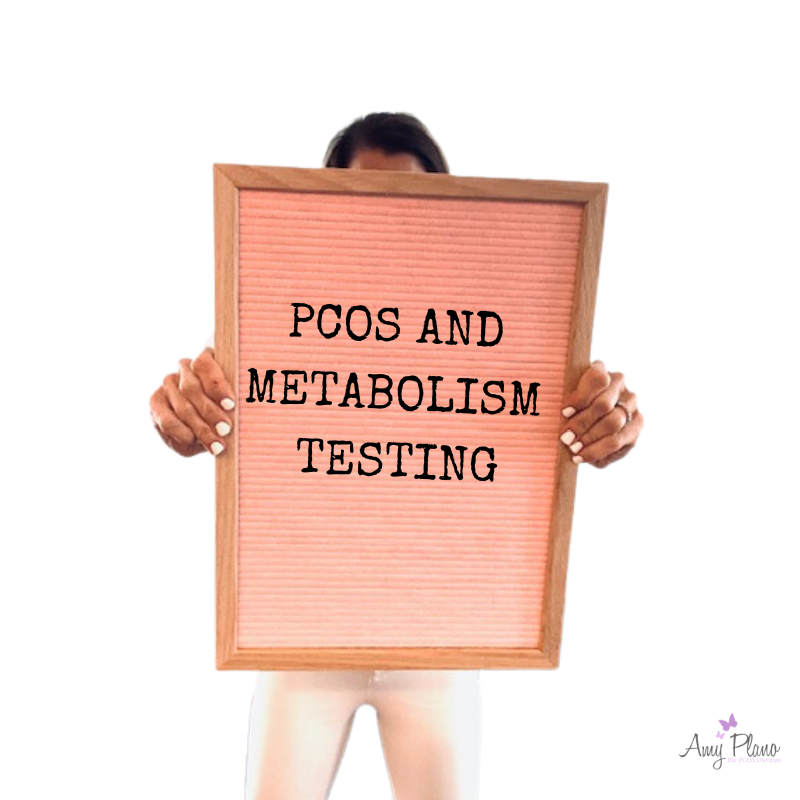
There are many factors that determine our metabolism. They include:
- Your body size and composition. People who are larger or have more muscle burn more calories. Even at rest, these folks tend to have higher RMRs.
- Your sex. Men usually have less body fat and more muscle than women of the same age and weight, which means men burn more calories at rest (Boo!) But don’t worry, I will be sharing some tips for how we chicks can optimize our metabolisms.
- Your age. As you get older (sigh), the amount of muscle you carry tends to decrease. Fat accounts for more of your weight, slowing down calorie burning.
Two other important factors that determine how many calories your body burns each day:
Food processing (we call this thermogenesis!)
Did you know that digesting, absorbing, transporting, and storing the food you consume also burns calories? Score! About 10 percent of the calories your burn each day come from the digestion and absorption of food and nutrients.
Physical activity
Physical activity and exercise— account for the rest of the calories your body burns up each day. Physical activity is by far the most variable of the factors that determine how many calories you burn each day.
So now you know what makes up your metabolism we can finally get down to good stuff!
Below are my top three reasons why metabolism testing for PCOS is so stinking important.
No more guesswork
How many times have you entered your height and weight into an online metabolism calculator only to get some crazy number which you have no idea how to interpret?
I cannot tell you how many times patients come into my office following a calorie level that is completely wrong for the goals they are trying to accomplish. This frustrates the heck out of me. It’s not that they are unsuccessful for lack of trying. It’s simply because they have been provided with the wrong information.
By having your metabolism tested you will now know the exact number of calories your body needs to accomplish your dietary and fitness-related goals. There is no more guessing or even second-guessing where your calories need to be! Through the use of cutting-edge technology, we can help you determine the exact amount of calories you need to reach your goals. Headache solved. Period. End of story.
Provides an accurate baseline
Girl, you have BIG goals which I love and admire. However, how can you accomplish your goals if you don’t know where to start? Conducting metabolism testing for PCOS will allow you to establish a solid baseline. Therefore, as things like your body composition, weight, or performance markers change over time you can adjust your calories relative to your new goals.
Independent of what your specific goals are we all need a caloric starting point. If we don’t have a starting point or baseline and we start making changes to our diet how can we tell what specific calorie level is working? Simply put – we can’t.
Therefore, by having your metabolism tested before making any significant dietary and workout changes you are armed with an accurate, reliable calorie level to base your goals on.
It helps when you are stumped
Knowing your metabolic rate when you have PCOS can be critical when you are stumped. As mentioned previously many women base their goals around a calorie level that is not in tune with their goals.
Trying to gain lean muscle mass but struggling like crazy? It could be that your calories are too low. We all know that in order to build anything we need ‘extra’ resources, right? That extra might be money, resources, or time. The same goes for putting on muscle. In this case, the ‘extra’ needs to be in the form of calories. Therefore, for a woman aiming to put on muscle, they need to FIRST make sure they are taking in enough calories to do.
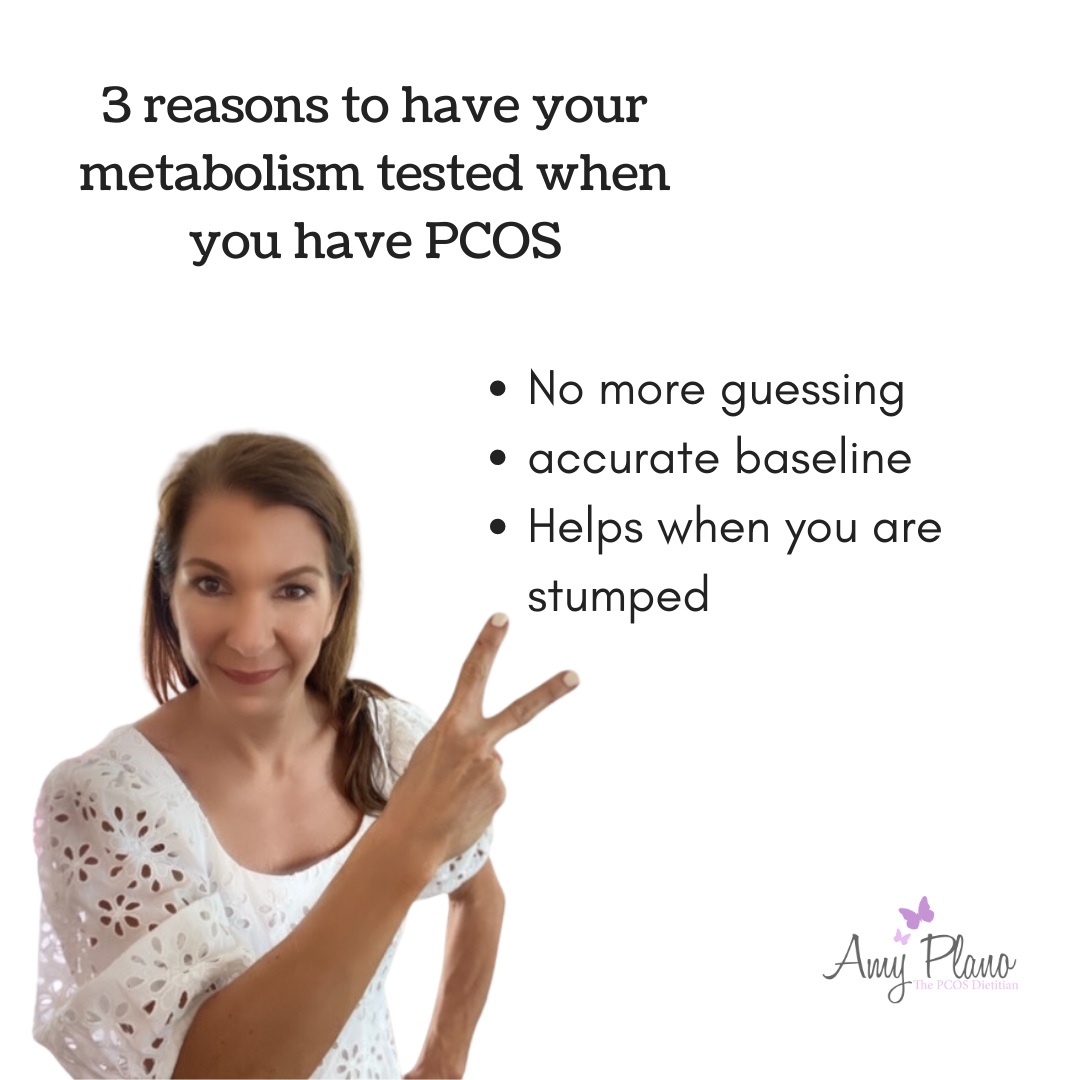
On the flip side, do you feel like you are at a weight loss plateau? Are you meticulously counting calories, carbs, protein, and everything under the sun and still not losing weight? Is MyFitnessPal definitely not your pal? For most people, the simple answer is their calories are not in tune with their weight loss goals. It could be that their calories are too low. Or it could mean that their calories are too high. How the heck will they know the store if they test their metabolism?
Next steps for metabolism testing for PCOS
So those are my top three reasons in support of metabolism testing for PCOS. I hope you found this information helpful. If you want to have your metabolism tested the cost is $150.00 and you would need to come to our Orange, CT office. It is a quick breathing test that takes less than 10 minutes. Plan for about 30 minutes for the entire visit.
Here is more info on how to prepare for the testing.
Shoot me an email at amy.plano@yahoo.com and I would be happy to provide additional deets. I go you, boo!
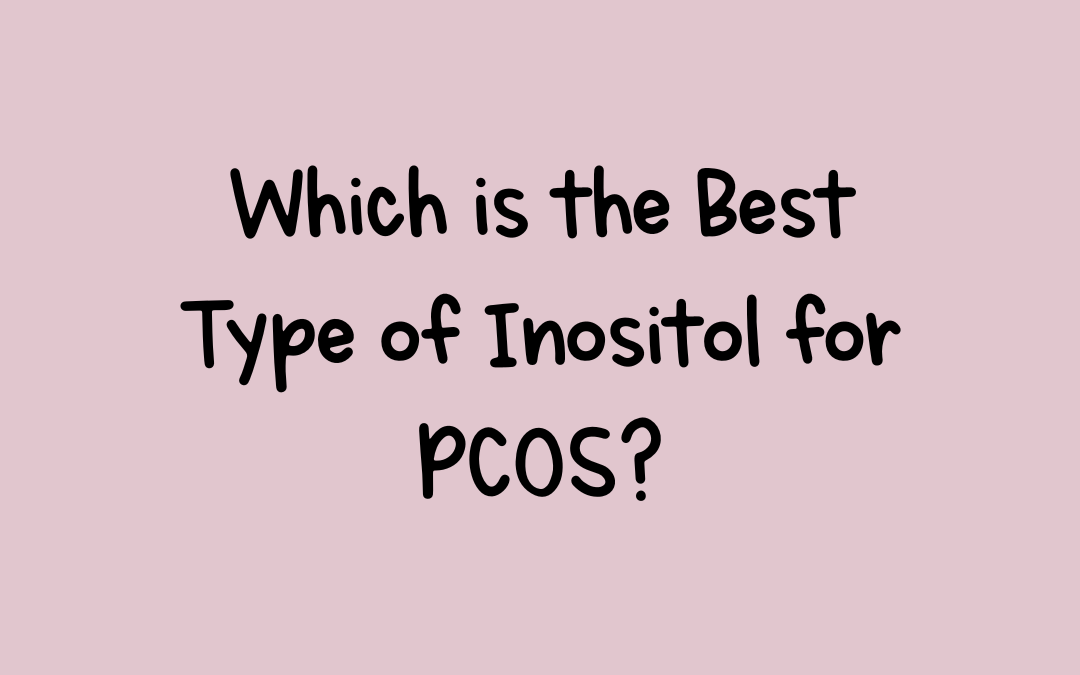
by AmyPlano | Jun 6, 2023 | General information about PCOS
Have you been struggling with finding the right treatment for your Polycystic Ovarian Syndrome (PCOS) symptoms? The supplement inositol may be the answer you have been searching for. But are you curious which is the best type of inositol for PCOS?
Inositol is a naturally occurring sugar that plays an important role in the body for healthy ovulation and fertilization.
For women with PCOS, inositol may have some powerful benefits such as restoration of a regular menstrual cycle, improved ovarian function, and improved fertility. Studies have shown that inositol can also reduce insulin resistance, which is often closely related to PCOS!
Are you interested in learning more about PCOS and insulin resistance? Head over to this page on my website to learn more about insulin resistance and how it can be a driver of PCOS.
Keep reading this article to learn what inositol is, how it can treat PCOS symptoms, a few of its benefits, and which type is best for you. Make sure to save this post for later and share it with a friend or loved one who needs it!
What is Inositol?

Maybe you’ve heard of inositol if you’ve been looking for different options to treat PCOS, or maybe the term is new to you. Either way, this section is going to be a great resource to explain everything you need to know.
As I mentioned above, Inositol is a naturally occurring sugar. It has the same chemical identity as glucose but with a different structure. The compound is composed of 9 different stereoisomers, meaning that there are 9 different three-dimensional structures.
When we are talking about PCOS and the human body, we will only talk about 2 of the 9 stereoisomers: Myo-inositol (MI) and D-chiro-inositol (DCI).
MI and DCI have various important roles throughout the human body. A couple worth noting is decreasing blood sugar after meals and responding to insulin.
Inositol is an important treatment option to understand because it can be cheap and effective for PCOS patients. However, it can be confusing to know which type and supplement is right for you.
Don’t worry, we’re here to help! While we ultimately recommend working with a registered dietitian to formulate your supplement routine, having a base-level understanding is important as well.
Myo-Inositol vs. D-Chiro-Inositol
In this section, I will be providing a breakdown of the differences between MI and DCI. This will give you a basic knowledge set about their important roles in your body.
It’s key to understand these because inositol supplements for PCOS are usually made up of both MI and DCI.
Myo-inositol (MI)
- MI is most widely distributed in nature.
- It is most often consumed through fruits, beans, grains, and nuts.
- In addition to consuming MI, the body also makes it.
- MI breaks down glucose.
- In the ovaries, it is responsible for responding to the follicle-stimulating hormone (FSH), which signals for proper egg development and release, improves the growth of cells that become eggs, and regulates the hormone AMH which improves egg maturation.
- In the ovaries specifically, MI is needed at much higher levels compared to DCI. The ratio should be 100:1.
D-chiro-inositol (DCI)
- DCI is responsible for storing glucose within the body in the form of glycogen.
- It’s higher in organs that need immediate access to energy like the liver and muscles.
- In the ovaries, it increases testosterone levels in response to insulin.
Both
- Naturally occurring and found in nature.
- Play an important role in glucose metabolism.
- Participate in the body’s response to insulin.
- Have specific roles in follicular development.
As you can see, MI and DCI have different functions in the body. Because of this, they are needed in different amounts. A regular ovary balance of the two will support normal hormonal secretion and ovarian function.
The ideal ratio of MI to DCI in follicular fluid is 100:1. In patients with PCOS, the ratio has higher amounts of DCI. Further, patients have been found with ratios as low as 0.2:1, which can be the root of a lot of problems!
How Does Inositol Treat PCOS?

Now that you know what MI and DCI do, let’s put it all together to understand how inositol can treat PCOS!
Here are the steps:
- PCOS is associated with insulin resistance, which can be the root cause of PCOS.
- In the body, the ovaries are extra sensitive to excess insulin.
- Excess insulin can lead to unwanted effects of PCOS like high testosterone, difficulties with ovulation, and infertility.
- These unwanted effects in the ovaries are caused by the epimerase enzyme, which is activated by excess insulin. This enzyme converts MI to DCI which causes more testosterone production.
- Studies support that inositol can decrease insulin resistance and testosterone levels, therefore reducing unwanted side effects like acne, hair growth, irregular menstruation, and infertility.
In summary, high MI is needed for healthy ovulation and we don’t want too much DCI. Additionally, excess insulin can convert MI to DCI, which causes extra testosterone and unwanted side effects.
An inositol supplement can treat PCOS by restoring healthy levels in the body. Healthy levels increase insulin sensitivity, reduce excess insulin, and prevent ovaries from producing too much testosterone.
What are the Benefits of Taking Inositol for PCOS?
Are you curious about the specific benefits of taking inositol?
Here are what the studies are saying:
- Effects on metabolic processes
-
- Improved insulin sensitivity
- Decreased blood pressure
- Decreased triglycerides and total cholesterol
- Decreased BMI and fat mass
- Effects on hyperandrogenism (A medical condition characterized by high levels of androgens, most often caused by PCOS. Symptoms of hyperandrogenism may include acne, inflamed skin, hair loss on the scalp, increased body or facial hair, and infrequent or absent menstruation).
-
- Decreased androgen concentrations
- Increased sex hormone-binding globulin (SHBG)
- Effects on the menstrual cycle and Ovulation
- Improved menstrual regularity
- Improved ovulation rate
An inositol supplement can have some pretty positive effects for those struggling with PCOS.
Now you may be wondering, “What’s the catch?” A lot of patients ask if there are any unwanted side effects of inositol. There are currently no reported side effects at the recommended dose, which I will talk about next.
Which Inositol is Best for PCOS?

Now the part you have been waiting for: what in the world do I actually take as a supplement? There are so many options, how do I know what’s right?
The first important thing you should be looking for is a 40:1 ratio of MI: DCI. This has been proven as being the most beneficial ratio for improving PCOS symptoms!
The 40:1 ratio has been proven more effective than MI alone in reducing bad cholesterol and triglycerides. Even further, this ratio has even been shown to restore ovulation, which is amazing! Especially if you struggle with infertility.
Additionally, studies have shown that taking inositol in combination with folic acid can reduce symptoms of PCOS.
The second most important thing to know is to never take DCI on its own. Increasing DCI too much creates the loss of the beneficial reproductive effects that inositol can have. It needs to be in that specific ratio with MI to work effectively. In this case, more isn’t better!
Now you know that the 40:1 ratio is the best for treating PCOS, but what dosage should you take?
Inositol can be taken safely at 2,000-4,000 mg per day. It’s recommended to take two doses of 2,000 mg for best results. One in the morning and one at night. However, you will want to take the dose that your doctor or healthcare team recommends for you.
If you’re looking online or at the store, you may notice you can buy capsules or a powder form. The capsules are the same as the white powder but in tablet form. This choice is really up to you. The powder can be mixed in water, tea, or coffee. See what works best for you!
Lastly, remember to look for brands that follow good manufacturing practices (GMP) and always do your research.
Again I will mention how essential it is to talk to a doctor or registered dietitian before taking any new supplements. You do not want to supplement blindly and inositol may not be for everyone!
The Takeaway
Finding alleviation of your PCOS symptoms can be exhausting, and the millions of supplements to choose from can feel overwhelming.
The good news is, I am here to help! The most important thing to know is that you should look for a 40:1 MI to DCI ratio. For dosage, it should be between 2,000-4,000 mg per day.
While inositol is a cheap and effective treatment option, about 30% of patients are resistant to inositol treatment. So it’s not guaranteed to work for everyone! However, it may be an option to bring up with your healthcare team.
Don’t wait another minute frustrated with your PCOS symptoms. Together we can help you lose weight, get healthy AF, and find your happiness again. Read through my list of comprehensive, effective nutrition programs to find the perfect fit for you. Can’t wait to hear from you!
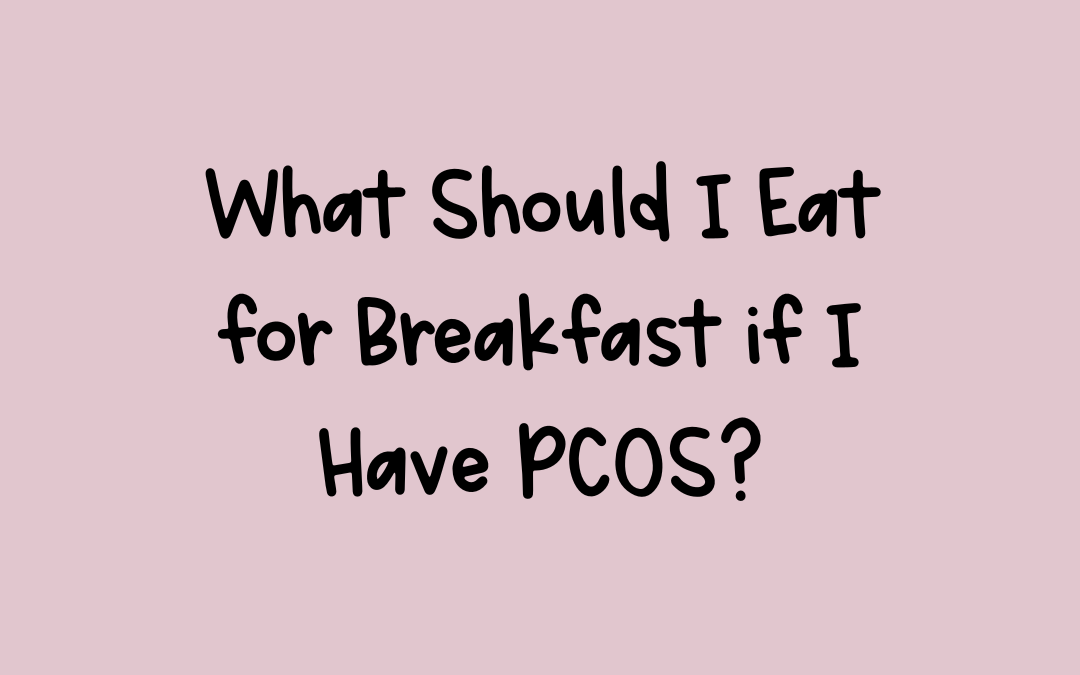
by AmyPlano | May 11, 2023 | PCOS Breakfast Foods, PCOS friendly recipes, Weight Loss
Are you wondering what to eat for breakfast if you have PCOS? Women with PCOS have unique nutrient needs and it is important to plan your PCOS breakfast ideas out accordingly.
Breakfast is one of the most-skipped meals of the day. Many of my PCOS clients come to me at first and admit they aren’t eating breakfast.
I hear lots of excuses for why they are skipping breakfast. Whether it is because you don’t have time, aren’t sure what to eat, or trying to limit your calorie intake, skipping breakfast is actually doing you more harm than good!
A balanced breakfast full of lean protein, complex carbs, and healthy fats, can boost your energy levels, stabilize blood sugar levels, and keep you satisfied until lunchtime. No more feeling “hangry” when 10 am rolls around.
Keep reading to learn why eating breakfast is important for PCOS, as well as six PCOS-friendly breakfast ideas from a specialized women’s health dietitian. Let’s get into it.
Need more PCOS-friendly meal ideas? Make sure you check out my high-protein meal ideas blog next!
Why is Eating Breakfast Important for PCOS?
When they say, “Breakfast is the most important meal of the day”, there is some truth to that statement. Breakfast is essential, especially for women with PCOS, because it starts your day off on the right foot.
It is easy to want to reach for a coffee first thing in the morning and push off eating until later. However, this can cause a dip in blood sugar levels and an increase in cortisol spikes (your stress hormone).
Since women with PCOS are prone to hormonal imbalances, neither of those is ideal for optimal hormone health. Instead, you can support your body to take on the day by giving it the nutrients it needs.
Even further, eating a nutritious breakfast can help prevent reactive hypoglycemia, a sudden dip in blood sugar that occurs after not eating consistently. It can also help improve your insulin resistance, which is a hallmark characteristic of PCOS.
Components of a PCOS-Friendly Breakfast

If you aren’t new to my blog, then you know that I consistently talk about the importance of balancing out your meals. This means trying to have a component from each food group at as many meals as possible. Doing so can help ensure you are hitting all of your nutrient needs!
When it comes to creating a PCOS-friendly breakfast, it’s important to include a balance of lean protein, healthy fats, and complex carbs (preferably high-fiber). These components work together to help stabilize blood sugar levels, promote satiety, and provide sustained energy throughout the morning.
- Some great protein sources for breakfast include eggs, Greek yogurt, cottage cheese, tofu, and lean meats such as turkey or chicken sausage.
- Healthy fats can be found in foods like avocado, nuts, olive oil, seeds, and nut butter.
- Complex, high-fiber carbs can come from options such as fruits, vegetables, oatmeal, whole-grain bread, quinoa, or sweet potatoes.
By incorporating these into your breakfast routine, you can help manage your PCOS symptoms and set yourself up for a successful day.
Importance of Eating Breakfast for Weight Loss
As a PCOS dietitian, I often highlight that women with PCOS who want to lose weight should eat breakfast as part of their daily routine.
Eating a balanced breakfast can help reduce cravings and prevent overeating later in the day. Skipping breakfast, on the other hand, can lead to overeating and poor food choices throughout the day, as well as a sluggish metabolism.
When combined, this can cause unwanted weight gain and make it more challenging to reach your ideal weight.
In fact, research has shown that people who eat breakfast are more likely to lose weight and keep it off compared to those who skip it.
So, if you’re looking to lose weight and improve your PCOS symptoms, make sure to prioritize a healthy breakfast each day!
6 Healthy PCOS Breakfast Ideas
Curious about what a healthy breakfast looks like? Below I will be sharing six healthy breakfast ideas for PCOS. Try these out next time you need some inspiration on how to make your breakfast both delicious and nutritious.
Remember that these are simply ideas and feel free to modify them based on your food preferences.
Mexicali Breakfast Burritos

Breakfast burritos are a great balanced breakfast option because you can add whatever you’d like to the inside! These Mexicali-inspired burritos combine eggs with black beans, for an extra protein and fiber boost.
Make a couple of extra burritos, wrap in foil, and freeze them for the days when you are in a time crunch. Simply toss them in the microwave or reheat using an air fryer.
To make:
- Whisk together your eggs, add a splash of milk of your choice, and set aside. Saute diced onions and peppers in a large skillet on medium heat.
- Add black beans and diced tomatoes to the skillet. Next, pour your eggs over top of the vegetables. Cook until the eggs are cooked through.
- Warm whole-grain tortillas in a pan. Assemble your burritos using the toppings of your choice.
- Great options include avocado, salsa, pico de gallo, and fresh cilantro.
Mango Chia Seed Pudding
Chia seed pudding is an underrated breakfast choice. If you are wanting a break from Greek yogurt or can’t stomach dairy, chia seed pudding is a great alternative.
Chia seeds are high in both protein and fiber, making them perfect for a nutrient-dense breakfast. Add your favorite fruits and whole-grain granola on top to complete the meal. Chia seed pudding is also ideal for on-the-go because there is no reheating required!
To make:
- Combine chia seeds, milk of choice, honey, and vanilla extract in a bowl or mason jar. Cover and refrigerate for at least 2 hours or overnight.
- When you are ready to eat, pour chia seed pudding out. Dice up your fresh mango and put it on top.
- For additional crunch, add whole grain granola, coconut flakes, and/or mixed nuts.
Breakfast Sandwich with Sweet Potatoes
Nothing is better than a good breakfast sandwich, right? The key is to use high-quality, PCOS-friendly ingredients such as lean protein sources and whole-grain bread.
Making your breakfast sandwiches at home can lower saturated fat and sodium content. Add a serving of diced sweet potatoes on the side to keep you satisfied until lunchtime.
To make:
- Preheat oven to 400°F. Line a baking sheet with parchment paper.
- Toss diced sweet potatoes with olive oil, smoked paprika, garlic powder, salt, and pepper. Spread the potatoes out on the baking sheet. Roast for 20-25 minutes, or until the potatoes are tender and golden brown.
- In a large skillet over medium heat, fry the eggs. Slice and toast whole-grain English muffins until golden brown.
- To assemble the sandwiches, place a handful of baby spinach on the bottom half of each English muffin. Top with sliced avocado, and a fried egg. Place the top half of the English muffin on the egg to finish the sandwich.
- Throw your diced sweet potatoes on the side for a complete meal!
Tofu Scramble on Toast
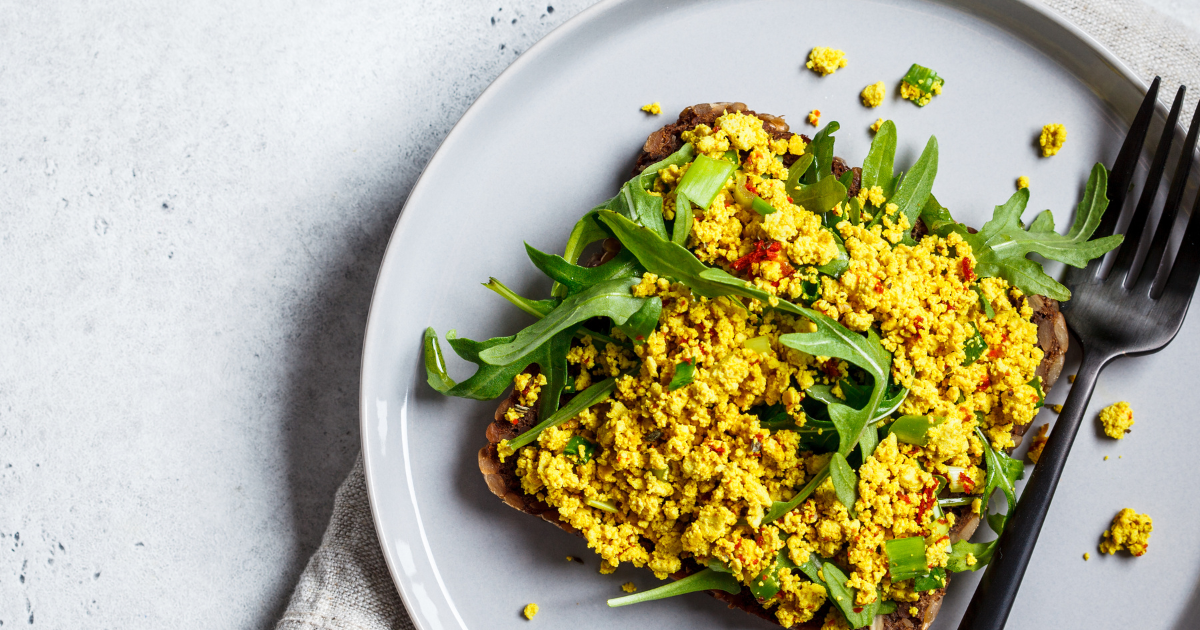
Tofu scramble is a common plant-based alternative to scrambled eggs. So if you don’t eat eggs, or are feeling like changing it up, try this scramble instead.
The secret ingredient is ground turmeric which turns the tofu a familiar yellow color. Turmeric is also said to be anti-inflammatory, making it beneficial for women with PCOS.
To make:
- Heat 2 tbsp of olive oil in a pan. Saute onions and diced peppers.
- Grab your extra firm tofu and crumble it into the pan. Add turmeric, garlic powder, paprika, black pepper, and sea salt. Coat until tofu is cooked through and slightly crispy.
- Toast 2 pieces of whole grain toast. Add fresh arugula and tomato slices to the bottom. Top with your tofu scramble mixture.
Green Protein Smoothie Bowl
While regular smoothies are great, they can sometimes lack sufficient calories and protein to keep you from getting hungry right after.
To combat this, you can create a protein smoothie bowl. By adding in a high-quality protein powder, you are contributing towards hitting your protein goals for the day.
This smoothie bowl is also very nutrient-dense since it is filled with dark leafy greens and healthy fats from the avocado. Avocado in smoothies? Yes, that’s right! It can give your smoothie a more thick consistency and you don’t even taste the flavor.
To make:
- Combine banana, frozen mango chunks, milk of choice, spinach, avocado, and vanilla protein powder in a blender and blend until smooth.
- Pour the smoothie into a bowl.
- Add your desired toppings, such as extra sliced banana, fresh berries, whole-grain granola, unsweetened shredded coconut, or chopped nuts.
Smoked Salmon Sandwich
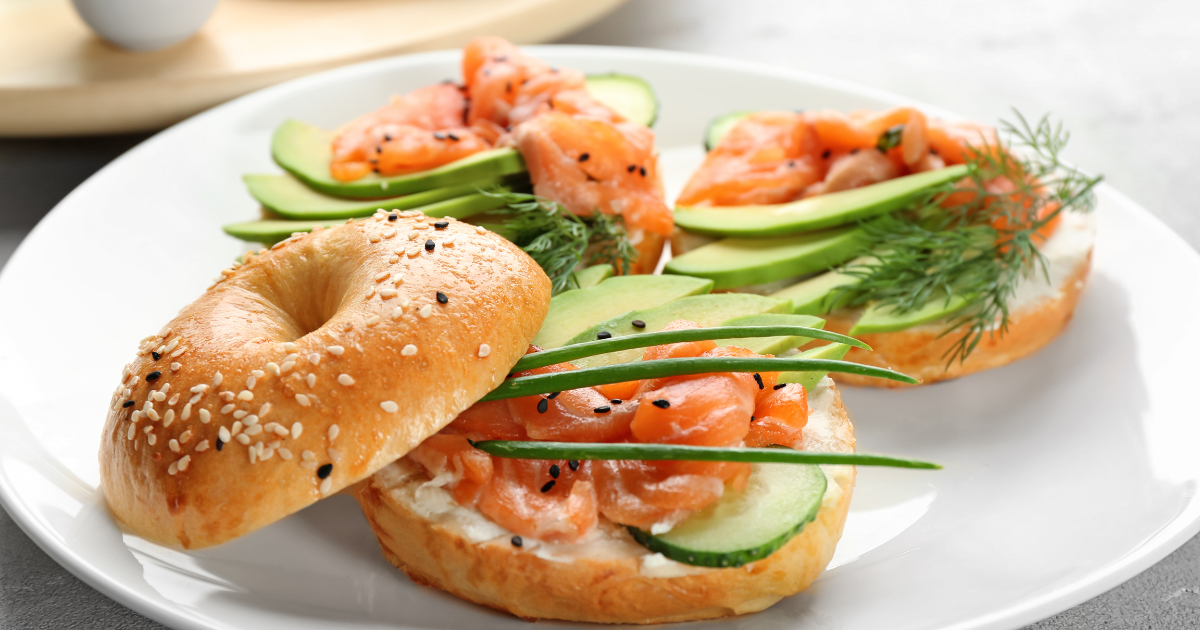
The last breakfast idea I have for you all is perhaps the easiest to make. Smoked salmon bagels are extremely simple and quick to whip together in the morning, with no pots or pans required.
Salmon is a PCOS-friendly food because it is high in beneficial omega-3 fatty acids. You can find sliced smoked salmon at most grocery stores.
To make:
- Toast your favorite whole-grain bagel. Spread low-fat cream cheese on top.
- Add your smoked salmon, fresh dill, cucumbers, and avocado slices.
- Enjoy on its own or with roasted potatoes on the side!
PCOS Breakfast Ideas: The Takeaway
What if you are feeling tight on time in the morning? Don’t worry, this happens to the best of us. Make sure you have easy PCOS breakfast ideas on hand as well for the days you are in a time pinch.
You can also batch-prep many of these meals ahead of time to have over a few days. This can save tons of time in the long run!
Overall, the most important thing is that you are taking the time to fuel your body in some way in the morning. Not only can this promote weight loss, but it can help balance out your hormone levels as well.
Want to take the guesswork out of meal planning? Our customized PCOS meal plans and programs help women with PCOS:
- Improve fertility, lose weight, increase energy levels, improve mood, and more!
Don’t wait another minute frustrated with your PCOS symptoms. Together we can help you lose weight, get healthy AF, and find your happiness again.
Read through my list of comprehensive, effective nutrition programs to find the perfect fit for you. Can’t wait to hear from you!
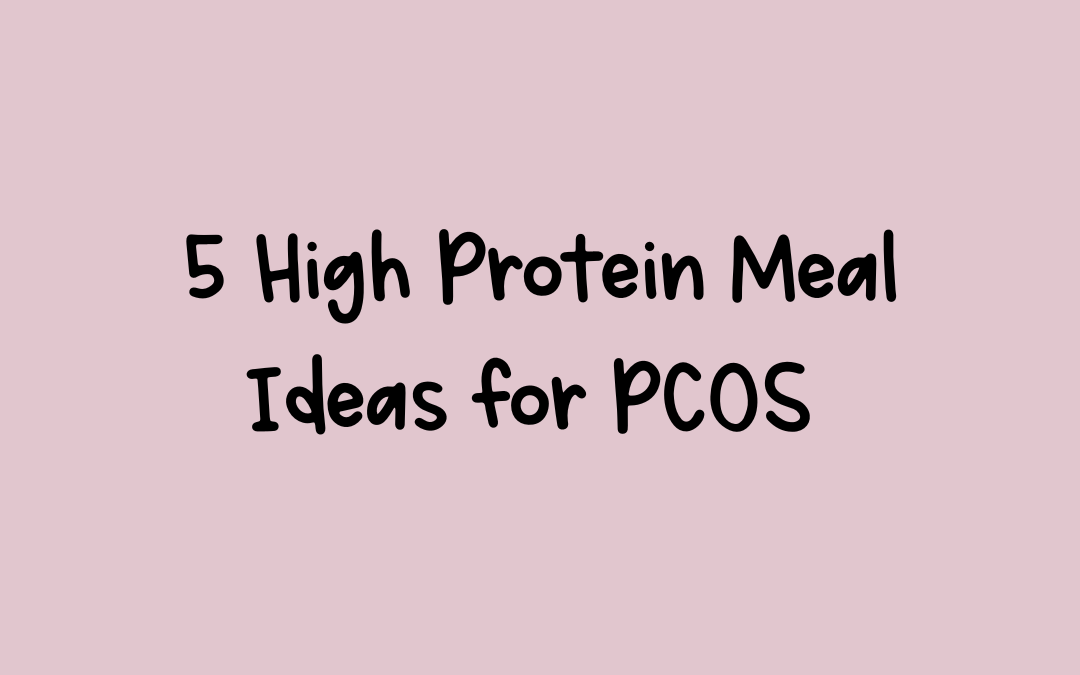
by AmyPlano | Apr 22, 2023 | General information about PCOS, PCOS friendly recipes, Weight Loss
Are you looking for high-protein meal ideas that are PCOS-friendly? Polycystic Ovarian Syndrome (PCOS) is a hormonal and metabolic disorder characterized by irregular or missing periods, increased androgens (male hormones), and multiple ovarian cysts.
While PCOS can cause many unwanted symptoms including acne, abnormal hair growth, and weight gain, a healthy diet can play an essential role in managing these symptoms.
Protein is one of the most important macronutrients for a healthy PCOS diet. Incorporating high-protein meals into your day can help regulate blood sugar levels, reduce insulin resistance, and promote weight loss.
In today’s article, I will be going over how to build a PCOS-friendly dinner plate that prioritizes protein. I will also be providing you with five high-protein meal ideas for when you need some inspiration in the kitchen!
How Can High Protein Meal Ideas Help with PCOS?
When you are first diagnosed with PCOS it can be very difficult to know where to turn and what to eat. Diet is so crucial to managing PCOS symptoms because 50-70% of women with PCOS have insulin resistance.
In general, a PCOS diet should focus on:
- Lean protein sources
- High fiber foods
- Omega-3 fatty acids
- Anti-inflammatory foods
- Low glycemic index foods
Lean protein sources are especially important for PCOS and are what we will focus on in today’s blog. Since women with PCOS are often insulin resistant, their bodies may have a harder time processing carbohydrates.
Protein, on the other hand, has little effect on blood sugar levels and can help regulate insulin secretion, making it an ideal macronutrient for women with PCOS.
Additionally, protein has been shown to promote feelings of fullness, which can help reduce overeating and promote weight loss. Weight loss can be very challenging with PCOS, but is important for managing the condition.
If you need additional guidance, consulting with a specialized PCOS dietitian like myself can help to ensure you tackle your PCOS symptoms and loss weight sustainably.
How do I Build a PCOS Plate?
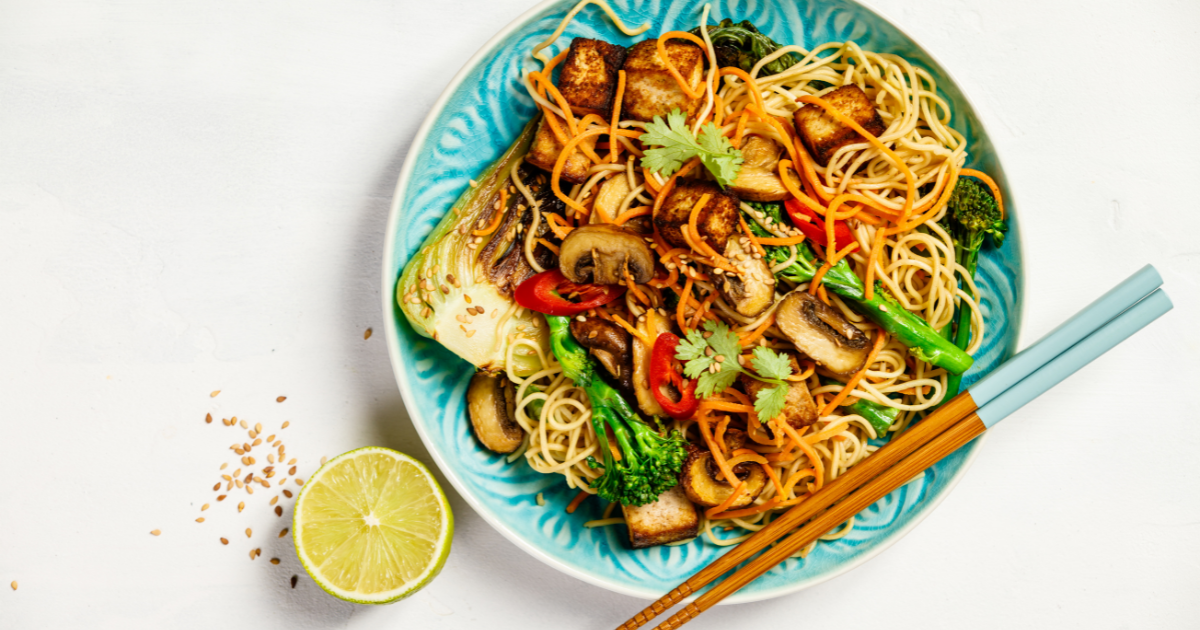
While I give you all the information and the types of foods you should be eating in my PCOS-friendly food blog, I understand the difficulty of taking these separate food components and building them into a meal you look forward to eating.
Here are a few tips for building a PCOS Plate:
- Aim for 20+ grams of protein per meal (3-4 ounces of chicken, meat, or fish)
- Fill half your plate with non-starchy veggies (broccoli, leafy greens, Brussels sprouts, etc.)
- Fill ½ of your plate with whole grains or starchy veggies (potatoes, beans, squash, quinoa, and brown rice)
- Add a healthy source of fat (avocado or olive oil)
Combining all of these elements into a meal will create a blood sugar-balancing plate that will keep you satisfied and your hormones happy- making it perfect for PCOS.
High Protein Meal Ideas for PCOS
Now we will get into some high-protein meal inspirations that are PCOS-friendly. If you are struggling with what to make for your meals, try out one of these ideas below!
Remember that you can modify any of the meals based on your preferences and dietary restrictions.
Quinoa, Tomato, Corn, and Black Bean Salad with Grilled Chicken

Quinoa is a great source of whole grains and also provides a solid amount of protein at eight grams per cup. Creating a quinoa salad full of fresh produce makes for quick and easy meal prep for the week.
Top the salad with 4-6 ounces of grilled chicken or turkey for an extra protein boost to keep you satiated until your next meal!
To make:
- Cook quinoa using the package directions. Add chopped cherry tomatoes, kerneled corn, and black beans.
- Make a dressing mixture with olive oil, lemon juice, balsamic vinegar, and honey.
- Top the salad with 4-6 ounces of grilled chicken. Combine together and serve.
Sheet Pan Salmon, Sweet Potato, and Brussel Sprouts
This sheet pan salmon meal is super easy to prep and makes for easy clean-up!
Salmon provides a great source of protein at 23 grams for 4 ounces. It is also high in beneficial omega-3 fatty acids.
Brussel sprouts are a high fiber, non-starchy veggie great for filling up and giving volume to your plate. Lastly, adding sweet potatoes gives you extra fiber as well as beta-carotene which is converted into Vitamin A in the body.
To make:
- Preheat oven to 400 degrees. Place fresh salmon on a sheet pan lined with aluminum foil.
- Cut up your Brussels sprouts and sweet potatoes. Place around the salmon fillets.
- Drizzle olive oil on top. Sprinkle salt, pepper, garlic powder, and paprika.
- Bake until the salmon reaches the proper internal temperature and the sweet potatoes are tender.
- Enjoy!
Greek Yogurt Parfait with Berries, Chia Seeds, and Flax Seeds

Greek yogurt is a solid source of protein at around 15 grams per serving. Additionally, greek yogurt provides beneficial probiotics for gut health as well.
Topping it off with some fresh berries is a great way to add in some fiber and antioxidants. Combining with other toppings such as chia and flax seeds makes this an amazing blood sugar-balancing breakfast that you can eat on the go.
To make:
- Choose your favorite non-fat Greek yogurt.
- I love Two Good and Fage because of their high quality and low sugar content.
- Wash and prep your berries of choice. Add them on top of the yogurt.
- Choose the rest of your toppings. Ideas include:
- Flax, chia, and hemp seeds, pumpkin seeds, low-sugar granola, mixed nuts, nut butter, and honey for a bit of sweetness.
Tofu and Veggie Stir Fry
For my vegetarian PCOS ladies, a tofu veggie stir fry can be a perfect high-protein meal option to include in your diet. Tofu is a source of soy protein that has been researched to improve insulin resistance and decrease oxidative stress and excess androgens.
To make:
- Press the tofu to dry and season it with garlic powder, pepper, and a little salt.
- Throw into a frying pan with some olive oil and minced garlic and cook till crisp.
- Cook in the same pan broccoli, fresh green beans, and peppers to give the meal some fiber.
- Prepare and cook brown rice noodles according to their package. Brown rice can also be used.
- Top with coconut aminos, a healthier alternative to soy sauce, and enjoy!
Grass Fed Beef and Bean Tacos with Whole Wheat Tortillas

Grass-fed beef is a great source of protein, iron, and B Vitamins. It differs from grain-fed beef because it has less saturated fat which can cause inflammation in the body.
Cooking up ground grass-fed beef with low-sodium taco seasoning serves as a great base for your next Taco Tuesday. Adding black beans to the taco along with sliced avocado and salsa can add some extra flavor as well as fiber and healthy fats.
To make:
- Prep your grass-fed ground beef and saute it in a pan. Add low-sodium taco seasoning.
- Rinse and drain a can of black beans. Add to the ground beef.
- Saute vegetables of your choice, my favorites are roasted peppers and onions, broccoli, and zucchini.
- Heat whole wheat tortillas and start assembling your tacos.
- Top with sliced avocado, salsa, and/or pico de gallo. If you are looking for a healthier sour cream alternative, try Greek yogurt mixed with spices.
High Protein Meal Ideas for PCOS: The Takeaway
There are plenty of meal combinations you can cook up to manage your PCOS symptoms. These are just a few of my favorites that you can include in your meal planning.
Remember to try to include a protein source in as many meals as you can, to promote satiety and improve insulin resistance.
There is not one perfect meal for PCOS and I encourage you to mix it up. Try new foods and recipes to keep things interesting. Eating healthy does not have to be boring!
If you want further guidance on meal planning and nutrition around PCOS, in my nutrition coaching program, we work together to come up with a personalized plan that prioritizes high-protein meals and other macronutrients to achieve your health goals.
Don’t let PCOS control your life, take control of your health today and head over to my services page for support and guidance on your journey to your best health!
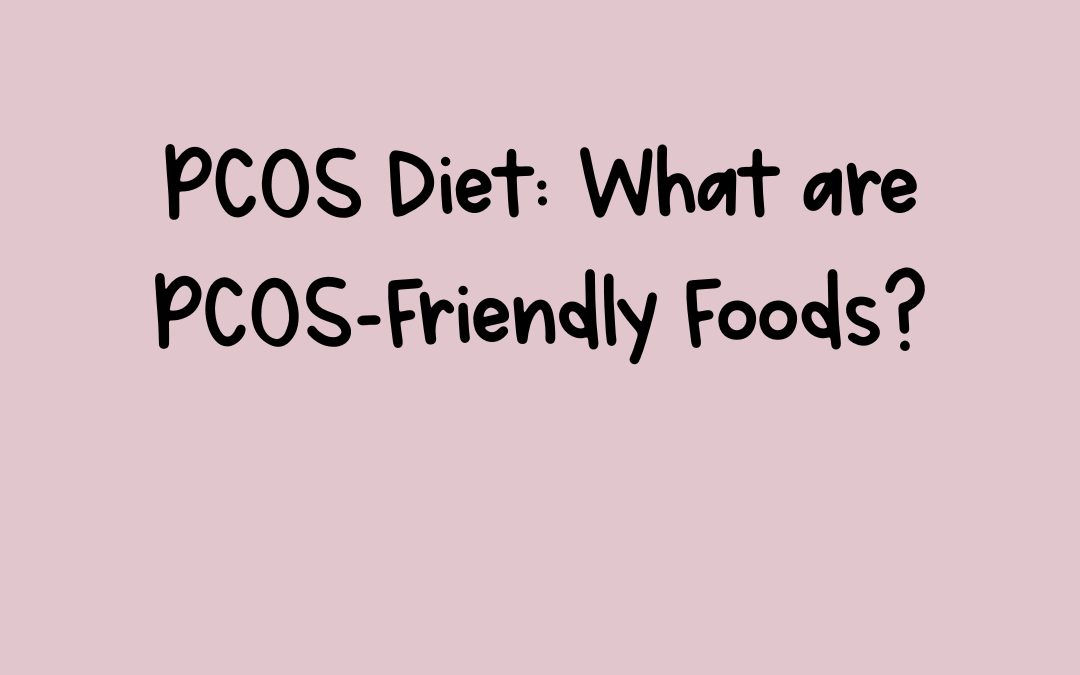
by AmyPlano | Apr 4, 2023 | General information about PCOS, Weight Loss
Polycystic Ovarian Syndrome or PCOS is a hormonal and metabolic condition that affects women all over the globe. If you have PCOS, you may be wondering what PCOS diet and lifestyle habits you can do to improve your condition.
Making dietary changes can help manage your PCOS symptoms, assist with weight loss, and treat hormonal imbalances. While there is no specific PCOS diet, there are certain foods and nutrients that you can add to your day to best support your health.
Keep reading to learn how your diet can play a role in PCOS and my favorite PCOS-friendly foods. These are foods that I recommend all of the time to my nutrition clients as a specialized PCOS dietitian!
How Can Diet Help Manage PCOS Symptoms?
Lifestyle and diet strategies are considered one of the first lines of defense against PCOS. What you decide to eat can help regulate your blood sugar levels, prevent insulin resistance, and manage your weight. These are common problems that women with PCOS face and lead to unwanted symptoms.
Here are a few benefits of a healthy diet for PCOS:
- Reducing inflammation
- Managing hormonal imbalances
- Improving fertility
- Promoting weight loss
- Regulating blood sugar levels and preventing further metabolic complications
- Increasing energy levels and overall quality of life
There is no one-size-fits-all PCOS diet. Each person will have unique dietary needs based on a variety of factors. It is always recommended to consult with your healthcare team or a registered dietitian before starting a new diet, supplement, or treatment protocol.
Can PCOS-Friendly Foods Help With Weight Loss?
Many women with PCOS come to me because they are frustrated that they aren’t losing weight. And trust me, I get it. Having PCOS can make it much harder to lose weight.
That being said, studies do show that women who can lose weight with PCOS have improved symptoms and metabolic markers. Which is hugely important for managing the condition!
Since PCOS can make weight loss more challenging, it may require a multifactorial approach. This means you will want to consider your physical activity, diet, supplement routine, and overall stress management techniques. You have to look at the full picture when it comes to PCOS weight loss.
While eating PCOS-friendly foods can help with weight loss, that is not the only goal of implementing a PCOS diet. The foods I have listed below will help you manage underlying hormonal issues associated with PCOS and weight loss can be a positive side effect.
PCOS-Friendly Foods to Prioritize

Omega-3 Fatty Acids
Omega-3s are types of polyunsaturated fatty acids that have many benefits for your overall health. The two main types of omega-3s are EPA (eicosapentaenoic acid) and DHA (docosahexaenoic acid).
Recent studies have shown that omega-3 fatty acids are beneficial for women with PCOS. They can help improve insulin resistance, which is a common driver and side effect of PCOS. Additionally, they were shown to improve other metabolic markers such as triglyceride and cholesterol levels.
Foods high in omega-3s include:
- Fish and other seafood, especially cold-water fish (salmon, herring, sardines, tuna, mackerel)
- Seaweed and algae
- Flax seeds, flax seed oil
- Walnuts
- Canola oil
It is important to note that plant-based sources of omega-3s are not as easily used by your body. Fish and fish oil are the best ways to get omega-3 fatty acids into your diet.
If you don’t like fish or are plant-based, you may want to consider taking a fish oil supplement to get your daily dose of omega-3s.
High-Fiber Foods
Dietary fiber is a type of carbohydrate and a component of plant foods that goes undigested in your digestive tract. Many people aren’t getting enough fiber throughout the day, which can have consequences for your overall health.
In fact, low intake of dietary fiber in women with PCOS is associated with insulin resistance and hyperandrogenism (excess male sex hormones). Both insulin resistance and high androgen levels can worsen PCOS symptoms.
Additionally, fiber is an important nutrient to help with weight management. It can increase your satiety and satisfaction after eating, which later on can curb your appetite and any cravings. An increase in fiber intake has been shown in studies to help with metabolic improvement and weight control in women with PCOS.
High-fiber foods include:
- Whole grains (quinoa, whole wheat, buckwheat)
- Legumes (lentils, beans)
- Nuts and seeds (chia, flax, walnuts, cashews)
- Fruits and vegetables (broccoli, apples, dried fruit, avocado, berries)
Lean Protein Sources
Protein is a vital macronutrient for many of your bodily processes. It can help you feel full for longer, satisfy cravings, stabilize your blood sugar levels, and more.
This macro is especially crucial for women with PCOS and should be prioritized at as many meals as possible. An increase in protein vs carbohydrates has been proven to increase weight loss and improve glucose metabolism in PCOS patients. Try to aim for around 15-20 grams of protein per meal.
Keep in mind that your protein intake should be primarily from sources that are lean and high quality. Protein that is high in saturated fats could have the opposite effect on your weight loss and metabolic markers.
Great sources of lean protein:
- Meat and poultry (turkey, lean and grass-fed beef, chicken)
- Eggs
- Greek yogurt
- Seafood and fish
- Plant protein (legumes, beans, tofu, tempeh, nuts, and seeds)
Low Glycemic Index Food
Low glycemic index (low GI) foods are foods that have a low value on the glycemic index scale. The glycemic index rates foods based on their ability to spike your blood sugar levels. Foods that rank low on the scale are less likely to raise your blood sugar than foods with higher values.
Eating low-GI foods can be beneficial for both weight loss and insulin resistance. When researchers looked at the effects of a low GI diet on PCOS, they found that it can have a variety of benefits.
A few studies found that it could positively impact fertility, hirsutism (dark hair growth), weight, and even emotional health. Because of this, low-GI foods seem to be a promising addition to a PCOS-friendly diet.
Some examples of low GI foods:
- Non-starchy vegetables (peppers, broccoli and other green vegetables, tomatoes, eggplant, lettuce)
- Fruits (berries, apples, lemon, limes, pears, avocado, apricots)
- Whole wheat/wheat bran
- Beans and legumes
Anti-Inflammatory Foods

Research has confirmed that chronic inflammation can be a big contributor to PCOS. Many women with PCOS are found to have higher levels of inflammatory markers.
Inflammation can lead to a whole host of negative consequences for your symptoms and the development of the condition.
One way to combat inflammation is to eat foods with anti-inflammatory properties. When emphasizing these foods, they can help correct hormonal balances, specifically by reducing your androgen levels.
Anti-inflammatory foods include:
- Berries (strawberries, blackberries, blueberries, raspberries)
- Cruciferous vegetables (broccoli, kale, Brussels sprouts)
- Green tea
- Olive oil and other healthy fats (nuts, fatty fish)
- Tomatoes
- Other leafy greens
PCOS Diet: The Takeaway
As you can see, there are plenty of PCOS-friendly foods that you can add to your diet plan. I encourage you to choose a few options from the lists above and plan them into your meals.
Regardless of the specific benefits, eating a diet that is nutrient-dense and diverse is one of the best ways to support your body.
If you are looking to take the guesswork out of your diet, working with a registered dietitian can be extremely helpful!
In my nutrition coaching program, we will work together to come up with a personalized plan to help you manage your PCOS and any other health goals that you have. There is no better time to invest in your health! Head over to my services page to learn more about my current offers today.



